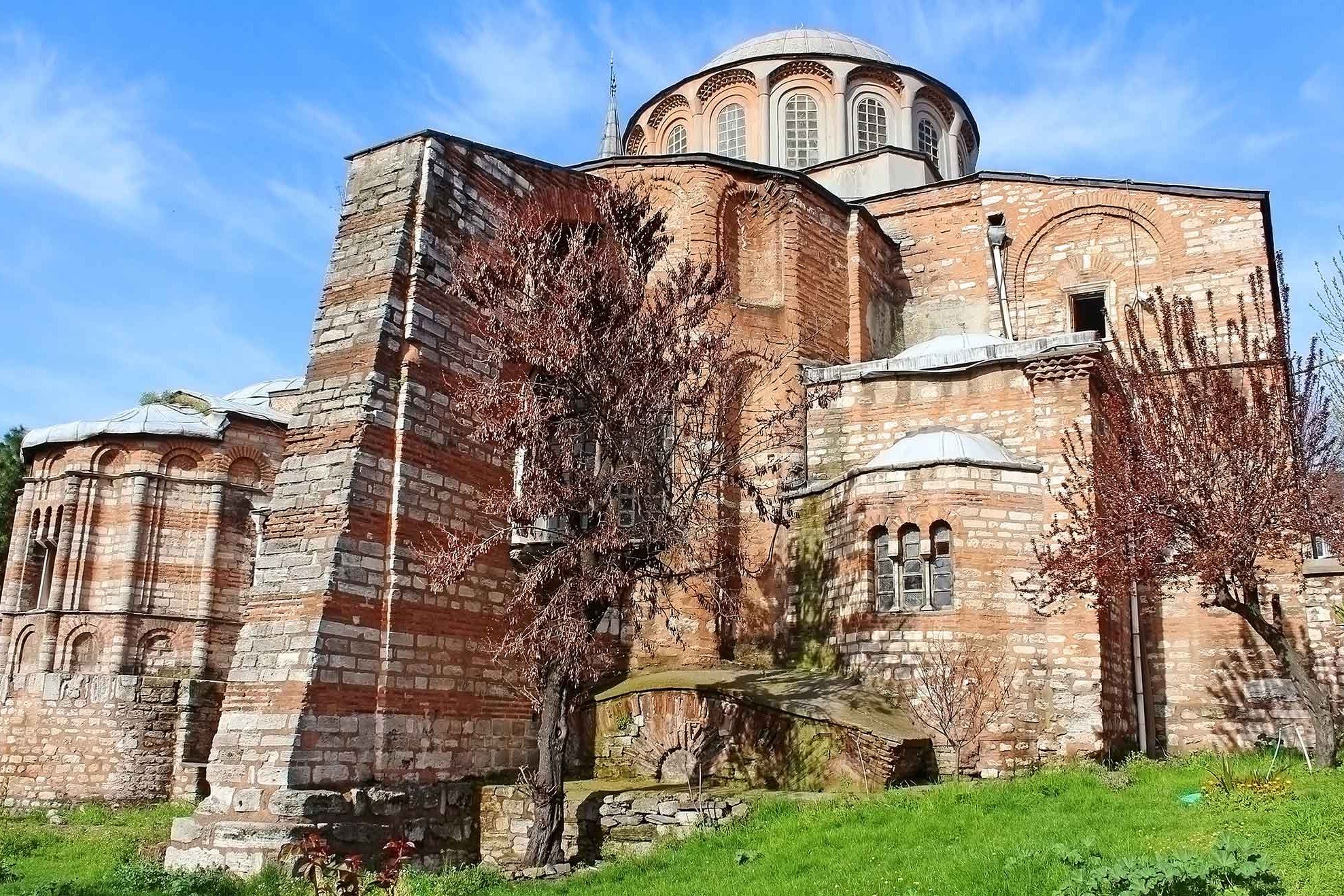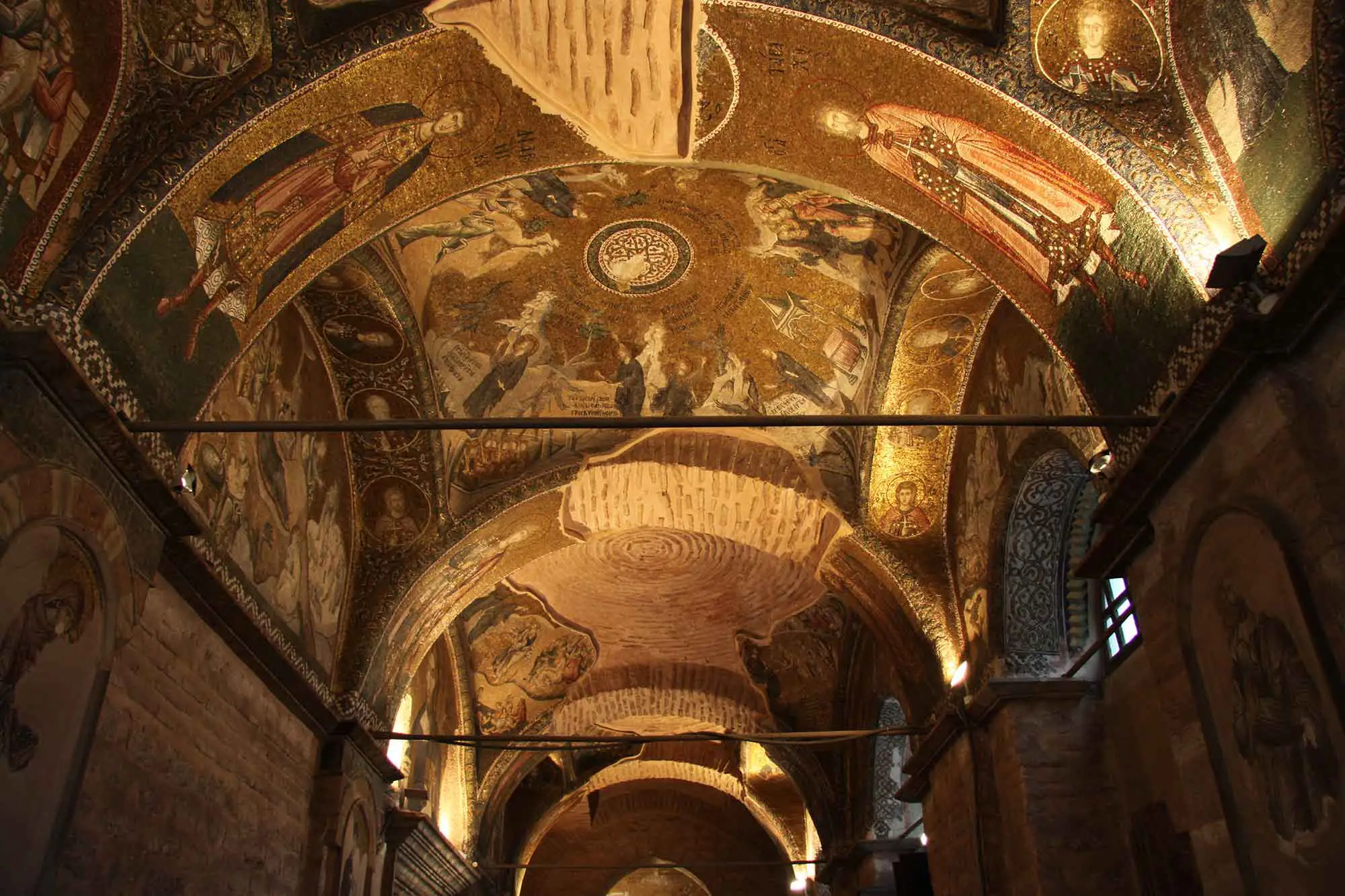Chora Church
The Chora is a church building that was the center of the Chora monastery, which was a large building complex during the Eastern Roman Empire, dedicated to Jesus. The name “Chora,” which means “Rural area” or “Out of town” in Greek, has been deemed appropriate for the building because it is outside the city walls of Constantine.
Early Period of the Monastery
Although we do not know the exact construction date of the building, according to a writer Symeon Metaphrastes, who lived in the late 10th century we have some records of the early stage. In 298, in Nicomedia (Iznik), St. Babylas, with his 84 disciples, were martyred and buried here at the beginning of the 4th century. Being a burials site for a saint and martyrs mad this area a sacred place. We know that the region where the Chora monastery is has started to gain importance as a sacred cemetery area (necropolis).
The Chora monastery was rebuilt in this sacred cemetery area in 536 in the place of a chapel in ruin by Emperor Justinian (527-565). According to an unproven claim by Manoil Gedeon on page 229 of the Christian feasts calendar, the Monastery was built in the 6th century by Theodoros, the uncle of Theodora, the wife of Iustinianus. However, it was destroyed by an earthquake on October 6, 557, before the completion. The Emperor built a more prominent monastery.
9th Century Monastery
Later, the Monastery became one of the most critical areas to bury high-class people. With the burial of Patriarch Germanos who died in 740, the Monastery gained its place in written sources for the first time. The blessing of the Monastery increased with the burial of the Nikaia metropolitan Theophanes, who died in the 9th century. After the building’s destruction during the iconoclastic period (711-843), there were restorations at different times. As a result of archaeological studies conducted between 1947 and 1958, the scholars determined that there were five different construction periods. In the 14th and 15th centuries, there were periods with major construction activities and repairs.
It is only the infrastructure on the east side that can reach today from the earliest building period covering the period up to the 9th century. We know from the graves and the wall-building technique that this infrastructure belongs to the 5th and 6th centuries, and it was not built as a crypt but was a burial site in the later periods.
At the end of the iconoclast period, after the Nikaia Council in 843, Mikhael Synkellos, who was the priest of the Monastery, rebuilt the Monastery with a big production campaign.
The traces of this building in the 9th century can only be seen at the eastern end of the church today. The tomb covered with a barrel vault under the Naos floor belongs to this period.
Latin Invasion and Chora Church
During the Komnenos period (1081-1185), they abandoned Great Palace and held the religious ceremonies at the Chora Church, with the use of the Blakhernai Palace in Edirnekapı. In the last quarter of the 11th century, Maria Doukaina, the mother-in-law of Emperor Alexios Komnenos (1081-1118), had built a new church on the ruined Chora Monastery. Remains of this building are visible at the bottom of the naos walls, under marble coverings. Since much of it has not reached today from its superstructure, we do not know the shape of the structure.
Isaakios Komnenos, the youngest son of Alexios I, rebuilt most of the Monastery in 1120. In the building, it replaced the previous three apse plan with a single and large apse, the relatively small dome standing on four pillars was enlarged and moved with four corner piers, the arches were narrowed, thereby creating an enormous interior.
There is not much information about the Chora Monastery during the Latin occupation between 1204 and 1261; however, if we consider the extensive construction activity of the Metokhites, it appears that the Monastery was devastated during the Latin invasion.
Theodoros Metokhites and the Chora Church
We know that the great earthquake in 1296 ruined the Monastery. Patriarch Athanasios I, who lived in Chora Monastery in the early 14th century, mentions that the Monastery was in a terrible condition.
II. In the time of Andronikos (1282–1328), although the empire was generally in poverty, it was in a wealthy aristocratic community that supported art and science. During this period, Theodoros Metokhites built the Chora Monastery almost from the beginning and created an extensive and rich library in the Monastery. Building or repairing a religious institution among the Byzantine aristocracy was considered their prestige in this world, and a significant investment for the next world in God’s sight.
Theodoros Metokhites is the son of an aristocratic family, born in Constantinople in 1270. His father, Emperor VIII. He is the ambassador of Mikhael Palaiologos before the Papacy. VIII in 1283. After the deposal of Mikhael was deposed, the new Emperor exiled the Metokhites family. During his exile, Theodoros Metokhites, who studied the Hellenic trivium and quadrivium and also learned ancient philosophy and religious science, was founded by Emperor II in 1290. He entered the entourage of Andronikos II, and at the same time, as a member of the Senate, he received the title of Logothetes; thus, the Senate appointed him as the treasury responsible for the treasury, the highest civil servant after the Emperor within the state bureaucracy.


Rise of Metokhites in the Palace
Theodoros Metokhites married his daughter to Emperor’s nephew Ioannes Palaiologos and established kinship relations with the imperial family. In 1316, he was appointed by the Emperor as a ‘ktetor’ (founder) to restore the Chora Monastery, which was under the protection and management of the palace. When Theodoros Methokhites completed the restoration of the Monastery in 1321, he the most prestigious title of the palace. This honor is the title of ‘Great Logothete.’ The gold gilding indicates this on the green background of two marble records of the large window of naos south typhanon. Respectively, “ktetor” is written on one side of the heading on the left and “Theodoros” on the other side and “logothetes” on one side of the different title and “Metokithes” on the other side.
Metokhites was proud of its Monastery and the extensive library it created, especially in this Monastery. Although there is no specific archaeological data about the building of this library, we understand that there is such a library in the Monastery both from Metokhites’ poems and letters sent to the monks of the Monastery while in exile. The Library of the Chora Monastery is known as one of the most important libraries of the Palaiologos period Constantinople.
The repairs by Metokhites were far-reaching. The central dome of the church, the two-story annex adjacent to the north (Annex), the interior and exterior narthexes and the additional chapel (parekklesion) in the south, as well as the marble covering plates and mosaics of the naos, the mosaic decoration of the narthex and the frescoes of the additional chapel, were built by Metokhites.
Metokhites, a high bureaucrat, wants his reputation in this world to continue after him. Reconstructing the Chora Monastery and equipping its library shows that he, as a good Christian, focuses on Heaven. The rich library, on the other hand, would convey its reputation in the world to the next generations and would earn God’s appreciation for the great reward it had processed.
Metokhites was a good Christian, but not bigoted. He took care of the church but did not favor discussing religious issues. He only preferred to be faithful.
Theodoros Metokhites After Exile
Emperor II. After Andronikos’ deposal from the throne in 1328, Theodoros Metokhites was exiled by the new Emperor to Thrace, Didymotekhos (Dimetoka), he lived in exile for two years, he explained the suffering, the years of exile in his poems with very intricate literary braids.
When he was allowed to return to Constantinople in 1330 with his son in law’s help, he went to Chora Monastery and became a priest in this Monastery by using his rights of ktetor. Metokhites was buried in the burial niche in the parecclesion adjacent to the south side of the church when he died in Chora Monastery in 1332.
Theology, Apocrypha and Chora
In addition to his achievements in the field of literature and politics, Metokithes was also very successful in the chronological harmony and iconographic narratives. Especially the great mastery and harmony and religious depictions he applied in the Chora monastery church in the structural analysis as well as in mosaic and fresco decorations. From this point of view, we can say that, together with the Renaissance movement that started with Giotto (1266-1337) in Italy, it led to the start of a new art movement in Byzantium.
Another feature that distinguishes Chora from other churches during this period is that it has chronological order of the Apocryphal Gospels, even though the scenes depicting Mary’s life are not in the four canonical Gospels. Metokhites added another mystical meaning to Chora and made the church of Mary, which is depicted as “Chora (meaning the womb in Latin), the place of the limitless, the place where Jesus fits into the mother’s womb, where he comes to life,” on the entrance door. He dedicated it, and he explained it in a poem he wrote.
The Ottoman Conquest
During the conquest of Istanbul by Fatih Sultan Mehmet (1451-1481) in 1453, the Ottomans did not damage the structure. Sultan Beyazid II (1481–1512), converted the Chora Church into a mosque and added a minaret. In the Turkish period, the monastic structures outside the church collapsed over time and disappeared.
Except for rebuilding the destroyed dome and repairing some earthquake damage, the outer narthex windows have been primarily closed, and they added a mihrab to the naos. They also removed the sarcophagi in the tomb arcosolium.
We understand from the narratives of the travelers who visited the building that wooden covers were covering the mosaics, and it was possible to open and close the artwork during the period when the building was a mosque.
In the first half of the 18th century, the Ottomans added a school and soup kitchen to the building by Kizlaragası Haci Besir Paşa (his death 1746). These additional structures have disappeared today.
The government of the Turkish Republic converted Chora Mosque into a museum with the decision of the Council of Ministers dated 29/08/1945. This fabulous museum, which is now called the Chora Museum, is a structure that attracts a lot of attention with its architecture, mosaics, and frescoes in Eastern Roman art. Chora Museum is one of the most visited sites in Istanbul, so we definitely recommend our guests to visit this museum.
Private Tours of Chora Church
If you are interested in visiting the Chora Church with an experienced private tour guide, please contact us! Our private tours are the best option to enjoy wonderful and complex sites such as the Chora Church.
Let us make your time in Istanbul a memorable one!